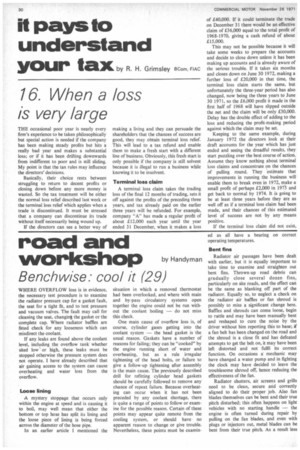it pays to understand
Page 30

Page 31

If you've noticed an error in this article please click here to report it so we can fix it.
your tax by R. H. Grimsley BCom. FIAC
16. When a loss is very large
THE occasional poor year is nearly every firm's experience to be taken philosophically but special action is needed if the company has been making steady profits but hits a really bad year and makes a substantial loss; or if it has been drifting downwards from indifferent to poor and is still sliding. My point is that the tax rules may influence the directors' decisions.
Basically, their choice rests between struggling to return to decent profits or closing down before any more money is wasted. So the tax treatment will be either the normal loss relief described last week or the terminal loss relief which applies when a trade is discontinued. It must be stressed that a company can discontinue its trade without itself necessarily being wound up.
If the directors can see a better way of making a living and they can persuade the shareholders that the chances of success are good, they may obtain terminal loss relief. This will lead to a tax refund and enable them to make a fresh start with a different line of business. Obviously, this fresh start is only possible if the company is still solvent because it is illegal to run a business while knowing it to be insolvent.
Terminal loss claim A terminal loss claim takes the trading loss of the final 12 months of trading, sets it off against the profits of the preceding three years, and tax already paid on the earlier three years will be refunded. For example, company "A" has made a regular profit of about £12,000 each year until the year ended 31 December, when it makes a loss of £40,000. If it could terminate the trade on December 31 there would be an effective claim of £36,000 equal to the total profit of 1968-1970, giving a cash refund of about £15,000.
This may not be possible because it will take some weeks to prepare the accounts and decide to close down unless it has been making up accounts and is already aware of the serious trouble. If it takes six months and closes down on June 30 1972, making a further loss of £20,000 in that time, the terminal loss claim starts the same, but unfortunately the three-year period has also changed, now being the three years to June 30 1971, so the £6,000 profit it made in the first half of 1968 will have slipped outside the net and the claim will be only £30,000. Delay has the double effect of adding to the loss and reducing the profit-making period against which the claim may be set.
Keeping to the same example, during January 1972 the directors look at their draft accounts for the year which has just ended and seeing the dreadful results, they start puzzling over the best course of action. Assume they know nothing about terminal loss claims and concentrate on the chances of pulling round. They estirnate that improvements in running the business will enable them to break even in 1972, make a small profit of perhaps £2,000 in 1973 and get back to normal by 1974. It is going to be at least three years before they are as well off as if a terminal loss claim had been made, and their chances of this estimated level of success are not by any means positive.
If the terminal loss claim did not exist, there would have been no reason why they should not struggle to re-establish the business. The chance of a terminal loss claim does not by any means force the directors to close down the company. but it certainly points in that direction, in some circumstances.
Past profits
In the other circumstance where the company has struggled for years without making any worthwhile profit and it slips gradually into the red, the terminal loss claim is of little consequence because there are no decent past profits to set it against. Here the directors should make up their minds between a drastic reorganization aimed at putting the company on a profit-making basis so enabling them to carry the loss forward against future profits or closing down before more money is wasted.
Formerly, it was possible for such a company with tax losses to be taken over by a more lively organization which could put it on its feet and in return take the advantage of the tax relief. Now this system is almost (but not quite) impossible. The right to carry forward the loss is forfeit if a change of ownership coincides within three years with a major change in the nature or conduct of the trade, or where the activities of the trade have become small or neglible and there is a change of ownership. for any considerable revival of the trade. This would appear to leave as the only hope of loss relief carrying over a change of ownership, the chances of returning to profitability owing to improved management.


















































































